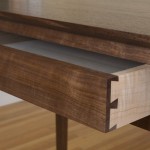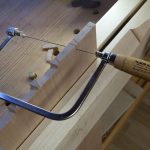We may receive a commission when you use our affiliate links. However, this does not impact our recommendations.
 When it comes to finish, I want something that is easy to apply, offers a little protection and doesn’t require spray equipment. And once I find a finish I like, I tend to be pretty loyal. I used Minwax’s Antique Oil Finish almost exclusively before a friend turned me on to Waterlox Original Sealer/Finish about a dozen years ago, and it’s been my go-to finish since. Both of these finishes are thinned varnishes that are easily applied with a rag. I’ve tweaked and refined my application methods a few times over the years, but because both are pretty much idiot-proof, the final result has always been satisfying.
When it comes to finish, I want something that is easy to apply, offers a little protection and doesn’t require spray equipment. And once I find a finish I like, I tend to be pretty loyal. I used Minwax’s Antique Oil Finish almost exclusively before a friend turned me on to Waterlox Original Sealer/Finish about a dozen years ago, and it’s been my go-to finish since. Both of these finishes are thinned varnishes that are easily applied with a rag. I’ve tweaked and refined my application methods a few times over the years, but because both are pretty much idiot-proof, the final result has always been satisfying.
I generally flood on a coat, wet-sand later applications with automotive sandpaper and then wipe it almost dry. I just lay on coats and build it up until I get the sheen I want. I’ve applied as few as three coats and as many as 20.
A friend once asked me how to apply it. I gave him a few different methods, including brushing, to choose from, but in the end I came to a realization. “It doesn’t really matter,” I told him. “Just make sure it’s sanded between or during coats, and apply them until it looks right.” It’s a flexible finish that has never given me much trouble. Until lately, that is.
Shortly before Christmas I was nearing the end of desk that was due to a client. I’d applied about five or six coats to the desktop, but it still didn’t have quite enough shine. I reached for the can of Waterlox and found it empty. The desk would have been fine as it was, but instead I drove a half-hour to Woodcraft and bought a new can.
Josh, who works in my shop, has put on plenty of finish and was used to Waterlox, so I handed him the can told him to go ahead and lay on another coat. When I walked back into the shop about about 10 minutes later I was struck by two things: 1) The smell was so strong and uncommon that I ignored the winter temperatures and immediately started opening windows and 2) The desktop looked horrible. The finish was dry in some spots, wet in others.
“Something’s wrong,” said Josh. “I don’t think this rag is any good. Too textured or something?”
We scrambled for a moment, but finally I resolved to let it dry and then try to save it later. How could anyone mess up Waterlox?
 The next morning I started to lay on another coat using wet-dry paper as always. I’ve used the stuff for years and have developed some kind of muscle memory that guides my application – and I can tell from the resistance under my hand how much time I have before it starts to dry. But something was wrong. One side of the small desk was dry before I was done working on the other side. And the smell! I though I was going to pass out, suffer brain damage, or both.
The next morning I started to lay on another coat using wet-dry paper as always. I’ve used the stuff for years and have developed some kind of muscle memory that guides my application – and I can tell from the resistance under my hand how much time I have before it starts to dry. But something was wrong. One side of the small desk was dry before I was done working on the other side. And the smell! I though I was going to pass out, suffer brain damage, or both.
I tried and tried. Nothing worked. This was clearly a different product. After a half-dozen attempts I got vaguely competent with its working qualities, but there was no time for wet-sanding during application as I’d always done before. It had to go on with a rag, and I had to sand between coats instead of wet-sanding at subsequent applications. The desk was delivered late, but I finally got the finish to look decent and the client was pleased.
When I bought a new can of Waterlox I compared the two. The one that had given me trouble had a subtle message in the sunburst on the can, “VOC Compliant,” I think it said. The new one, however, said, “Original Formula.” Eureka! I knew what to look for in the future, and I wouldn’t make the same mistake again.
A few days ago I was talking to Bob Flexner, our finishing guru, and he explained the problem. The new formula replaces the traditional solvent with one that is VOC exempt: paraclorobenzotrifluoride (PCBTF). The MSDS says they added 65 percent. Bob explained that it has dissolving qualities similar to mineral spirits, but it dries a little faster – this explained why one end of desktop dried before I could finish up my work on the other end. Bob also asked about the smell, which PCBTF is known for, but he confirmed that it isn’t toxic. Toxic or not, the smell certainly isn’t pleasant.
Luckily for me, the state where I live doesn’t have to sell the VOC-compliant version. Yet, at least. That Woodcraft was selling the VOC-compliant version was probably just a shipping error, I’m told. But I wonder, have you run into similar problems with VOC-compliant finishes, Waterlox or otherwise? If so, how has it affected your work?
To learn more about finishing from the guru himself, check out the sale on titles from Bob Flexner: Wood Finishing 101 and Flexner on Finishing. The always reliable Understanding Wood Finishing is also available.
Here are some supplies and tools we find essential in our everyday work around the shop. We may receive a commission from sales referred by our links; however, we have carefully selected these products for their usefulness and quality.










I really liked the original Lacquer Thinners made from 100% virgin thinner. This new Compliant formula is nothing more than 100% acetone and is not worth a crap, especially when thinning paint! Try removing paint from plastic, with this new compliant crap (acetone)! IT MELTS PLASTIC!! Leave it to the Haight-Ashbury/Tree Hugging nincompoops from California to ruin another great product! I’m sure that the gasses being emitted from congress far outweighs the dangers of real paint thinner! Furthermore, I wish California would break off and just float away!! That’s my 2 cents 😉
I’m not sure if is due to VOC compliance but has anyone tried to buy oil based varnish lately? I like to mix my own oil-varnish mix so I can increase the amout of varnish and decrease the oil in the later coats to get a quicker build and faster drying. I just ran out of varnish and went to buy some more but all my usual sources no longer carry it. I’ve read that Arm-R-Seal and Waterlox are il-varnish mixes and get good reviews. My local wood store (Woodworkers Source) carries Old Master’s tung oil varnish, has anyone used that? Sorry if I’ve sidetracked this post but it it frustrating when something you’ve used for years is suddenly gone.
Here in California we were forced to the VOC compliant finishes some time ago. There was a lot of grumbling during the transition, but guess what – the VOC stuff is really good now. I mostly spray lacquer and the water based stuff works well as long as you understand the differences between it and the older solvent based stuff. The water based is very clear – so much so that it appears white – so I shoot dewaxed shellac first to give an orange base. This makes the finish look the same as the older solvent based finish.
Final comment – the new finishes are quite good, you just have to learn the differences and how to work with it. If we had all started with low VOC finishes, we’d have difficulties with solvent based finishes.
I haven’t run into this problem with my woodworking yet, but with my day job in commercial roofing. As of Jan. 1, all of the states we work in went to VOC compliance on our adhesives. The thing is, all of the LVOC adhesives smell worse than the old “bad” materials. They’re also approximately 3x the cost, which has upset some of my customers. I’d expect that the cost of the finishes will do the same thing sooner or later.
Is this stuff a beeswax/oil blend that smells of orange? It looks like another product that I got years ago called Beeswax Wood Preserver by Lustre Products in Colorado.
If it is, I agree that it is really good.
Matthew, please explain further. I am confused when you say “I generally flood on a coat, wet-sand later applications with automotive sandpaper and then wipe it almost dry.” I gather you aply additional coats using wetsand paper. I have never heard of this before, but that’s not unusual. It’s the wipe ’til almost dry part that most confuses me. Do you just continue rubbing the newly applied finish with a cloth until it is nearly dry? Wouldn’t this become a mess as the finish gets tacky? Am I just off in the weeds on the whole subject?
Original Waterlox is a great fully cooked tung oil/phenolic resin varnish that produces beautiful results.
Thank you for sharing your experiences with the low-VOC imposter. Manufacturers are caught in a conundrum of compliance . Being green, like Kermit the frog sings, is not so easy.
I hope I don’t sound like a scold, but lax attention to health effects is a pet peeve of mine.
You may want to check the MSDS for PCBTF again “Inhalation: May produce symptoms of central nervous system depression, including headache, dizziness, nausea, loss of balance, and drowsiness.”
And the National Toxicology Program review describes human studies that identified the following issues: “Exposure induces skin, eye, and respiratory irritation, depression of central nervous system, and dermatitis due to defatting of the skin. Other symptoms include coughing, wheezing, a burning sensation, laryngitis, shortness of breath, headache, nausea, vomiting, lung irritation, chest pain, and edema. PCBTF is destructive to mucous membrane tissues.”
Sounds absolutely delightful.
Now, a lot of other compounds that woodworkers use have issues, but you need to be protecting yourself through acquiring information and using the proper Personal Protective Equipment (also listed in the MSDS). In your own shop those duties (typically of the safety manager in industry) are up to you.
Wearing a respirator won’t kill you, not wearing one might.
I am always looking for ways of adding to my finishing techniques and I enjoyed reading your posting. You mention rubbing out using General Finishes Oil and Wax Blend in one comment. I just finished looking at the GF site and could not find that product. The 3rd was my birthday and I realize that I’m getting older and subject to “Seniors moments” but can you direct me to the product listing?
I don’t think it’s the VOC-complaint-ness that’s the problem per se. It’s just that the Waterlox people haven’t done a very good job of reformulating their product to account for the different solvent. (They’ve been selling the low-VOC product in California for at least a couple of years, and I’ve heard similar complaints from other people during that time.)
I use other low-VOC finishing products (e.g., OSMO Polyx Oil; 207 g/l VOC compared to Waterlox Original’s 614 g/l) that work just fine.
-Steve
Good to know about your low VOC waterlox experience. Good article.
When I was researching waterlox before first time use I came across an interesting challenge – users were split on whether or not to sand btw each coat. Waterlox themselves say don’t sand. You and lots of others say to sand. Could you help me understand the difference?